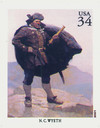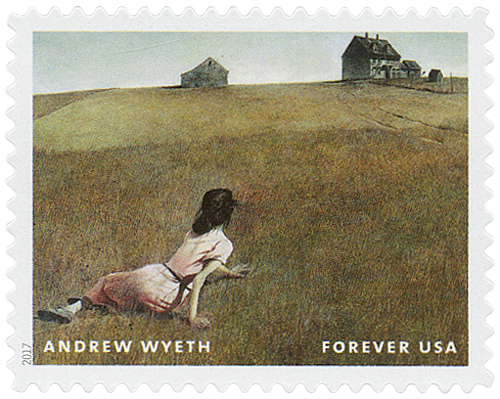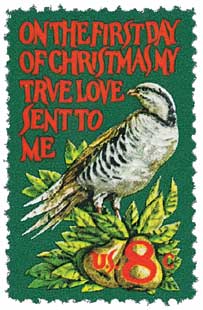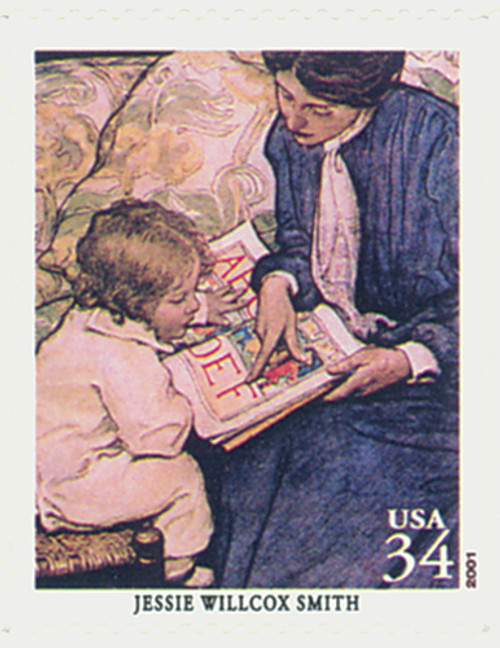
# 3502r - 2004 34c American Illustrator N. C. Wyeth
N.C. Wyeth
34¢ American Illustrators
City: New York, NY
Quantity: 125,000,000
Printed by: Avery Dennison Security Printing
Printing Method: Photogravure
Perforations: Serpentine die cut 11.25
Color: Multicolored
Birth Of Andrew Wyeth
Andrew Wyeth was the youngest of N.C. Wyeth and Carolyn Bockius Wyeth’s five children. N.C. was an affectionate father and famous artist, encouraging each of his children to pursue their own talents. Three, including Andrew, followed in N.C.’s footsteps and became artists.
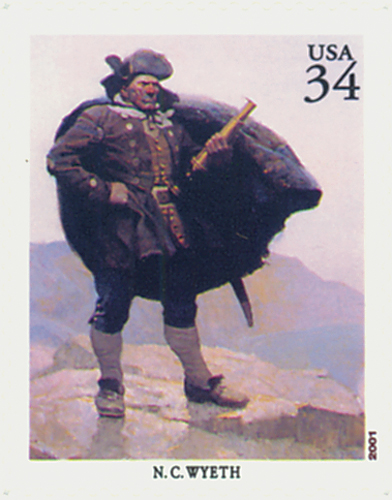
During his childhood, Wyeth was ill so often he was forced to leave school. After that, he received his education from his father. N.C. taught his son the fundamentals of drawing and watercolor painting as well as traditional school subjects like history and mathematics. He also had his son study Robert Frost, Henry David Thoreau, and other great literary masters. In fact, his father found it amusing and exciting that Andrew’s birthday fell on Henry David Thoreau’s 100th birthday. The works of these authors first influenced Andrew to paint the beauty he found in nature.
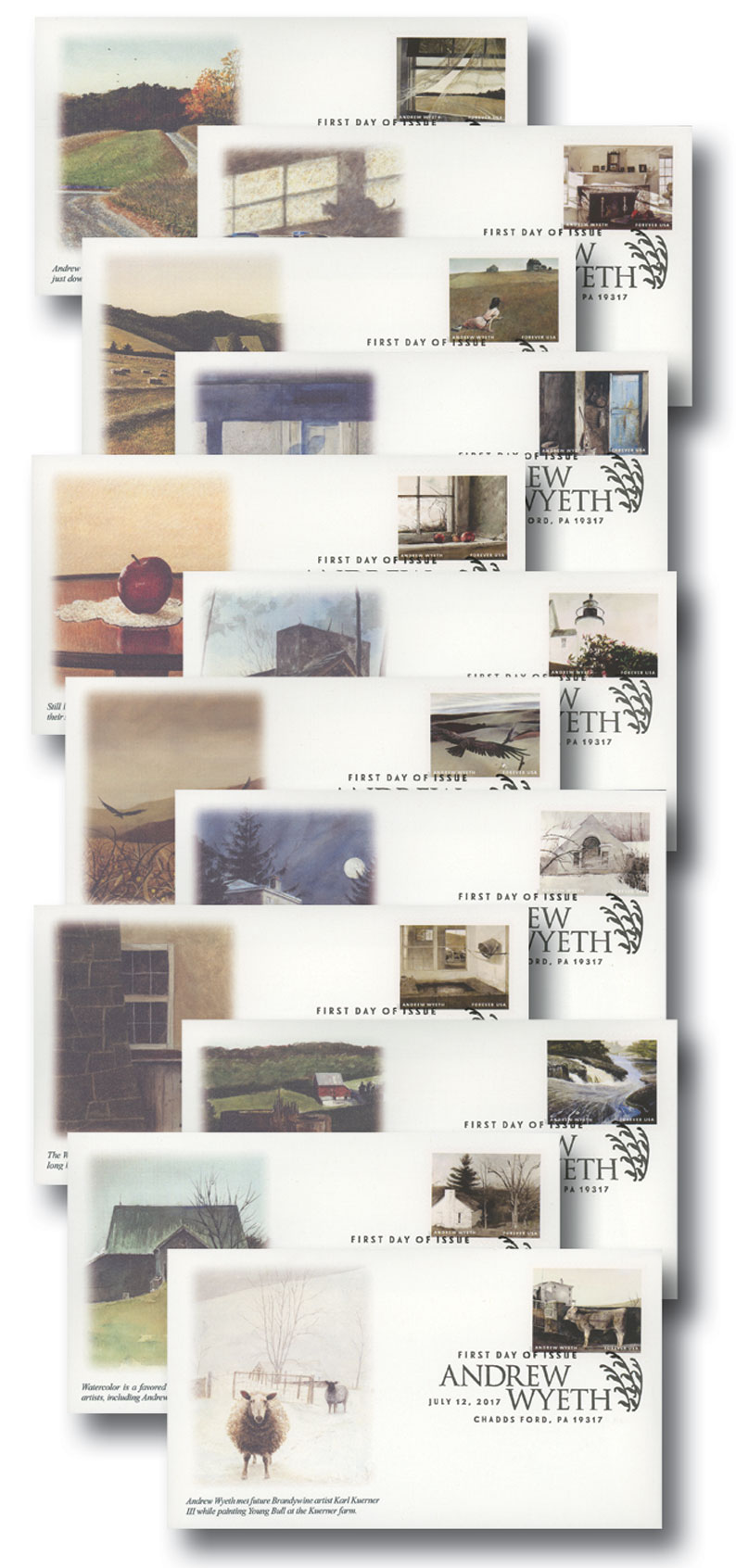
Most of Andrew Wyeth’s life was spent in his hometown. He painted a variety of subjects in Chadds Ford, but his favorite seemed to be Karl and Anna Kuerner’s farm. Wyeth produced over 1,000 of paintings and drawings of their property throughout his lifetime.
When not in Chadds Ford, Wyeth lived in his summer home in Cushing, Maine. He found an endless supply of inspiration in Maine’s people and completed many paintings while there. One of the most famous is Wind from the Sea, a highly detailed tempera depicting sheer curtains blowing into an upstairs room of the Olson house in Cushing, Maine.
Another famous painting from his time in Maine is Christina’s World. It depicts family friend Christina Olson. She and her brother Alvaro were common subjects for his paintings and their home was his favorite place to paint. In fact, their 14-room farmhouse was named a National Historic Landmark in 2011 for its role in Wyeth’s career.
Wyeth focused on regional subjects, seeking to showcase the extraordinariness in the everyday. Wyeth sought to create the same reactions in others he felt while painting – giving his work impressive depth.

Andrew Wyeth is famous for his attention to detail – he was said to “paint every blade of grass.” To achieve that precision, Wyeth’s paintings took many hours to finish. He worked in layers and thought about every brush stroke before he made it. With Wyeth’s watercolor pieces, like Alvaro and Christina, he used both wet and dry brush techniques. Wet was used for the basic colors and shapes, and dry was used to add textures and detail to the painting.
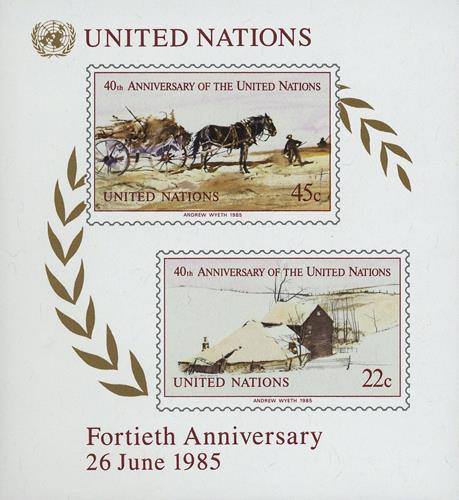
Wyeth’s paintings earned him an honorary degree from Harvard University in 1955. Eight years later, he was featured on the cover of Time magazine when President Johnson awarded him the Presidential Medal of Freedom – he was the first painter to receive this award. By the late 1980s, the selling price for Wyeth’s paintings had gone from $100,000 to over $1 million. In 1988, he received the Congressional Gold Medal.
N.C. Wyeth
34¢ American Illustrators
City: New York, NY
Quantity: 125,000,000
Printed by: Avery Dennison Security Printing
Printing Method: Photogravure
Perforations: Serpentine die cut 11.25
Color: Multicolored
Birth Of Andrew Wyeth
Andrew Wyeth was the youngest of N.C. Wyeth and Carolyn Bockius Wyeth’s five children. N.C. was an affectionate father and famous artist, encouraging each of his children to pursue their own talents. Three, including Andrew, followed in N.C.’s footsteps and became artists.

During his childhood, Wyeth was ill so often he was forced to leave school. After that, he received his education from his father. N.C. taught his son the fundamentals of drawing and watercolor painting as well as traditional school subjects like history and mathematics. He also had his son study Robert Frost, Henry David Thoreau, and other great literary masters. In fact, his father found it amusing and exciting that Andrew’s birthday fell on Henry David Thoreau’s 100th birthday. The works of these authors first influenced Andrew to paint the beauty he found in nature.

Most of Andrew Wyeth’s life was spent in his hometown. He painted a variety of subjects in Chadds Ford, but his favorite seemed to be Karl and Anna Kuerner’s farm. Wyeth produced over 1,000 of paintings and drawings of their property throughout his lifetime.
When not in Chadds Ford, Wyeth lived in his summer home in Cushing, Maine. He found an endless supply of inspiration in Maine’s people and completed many paintings while there. One of the most famous is Wind from the Sea, a highly detailed tempera depicting sheer curtains blowing into an upstairs room of the Olson house in Cushing, Maine.
Another famous painting from his time in Maine is Christina’s World. It depicts family friend Christina Olson. She and her brother Alvaro were common subjects for his paintings and their home was his favorite place to paint. In fact, their 14-room farmhouse was named a National Historic Landmark in 2011 for its role in Wyeth’s career.
Wyeth focused on regional subjects, seeking to showcase the extraordinariness in the everyday. Wyeth sought to create the same reactions in others he felt while painting – giving his work impressive depth.

Andrew Wyeth is famous for his attention to detail – he was said to “paint every blade of grass.” To achieve that precision, Wyeth’s paintings took many hours to finish. He worked in layers and thought about every brush stroke before he made it. With Wyeth’s watercolor pieces, like Alvaro and Christina, he used both wet and dry brush techniques. Wet was used for the basic colors and shapes, and dry was used to add textures and detail to the painting.

Wyeth’s paintings earned him an honorary degree from Harvard University in 1955. Eight years later, he was featured on the cover of Time magazine when President Johnson awarded him the Presidential Medal of Freedom – he was the first painter to receive this award. By the late 1980s, the selling price for Wyeth’s paintings had gone from $100,000 to over $1 million. In 1988, he received the Congressional Gold Medal.





